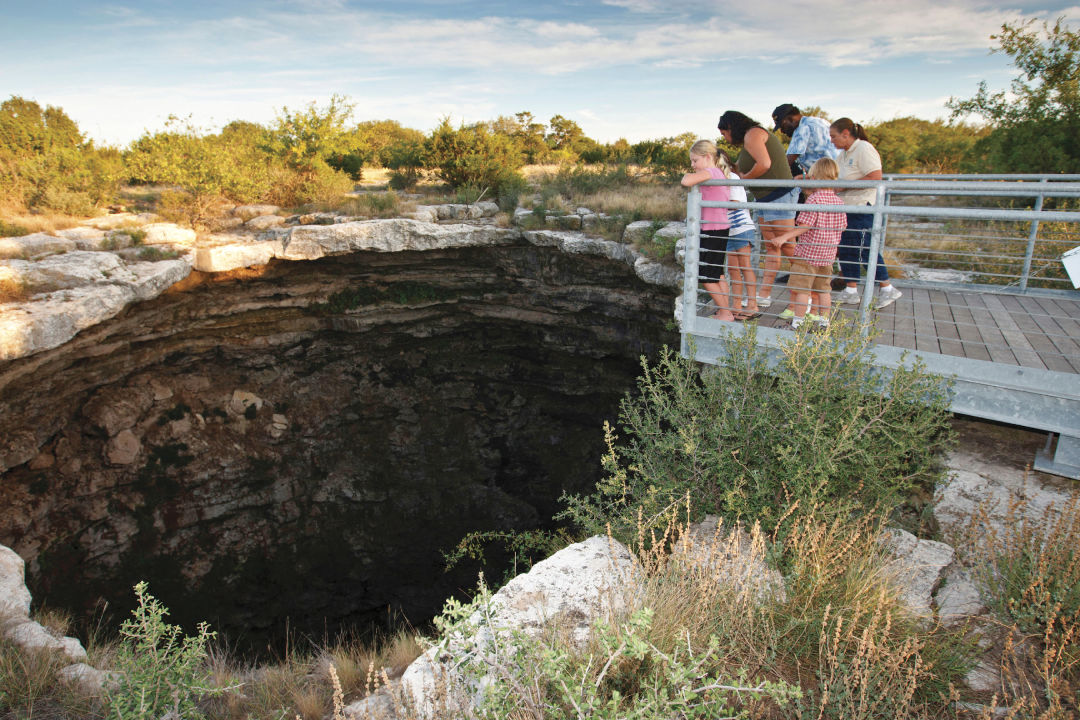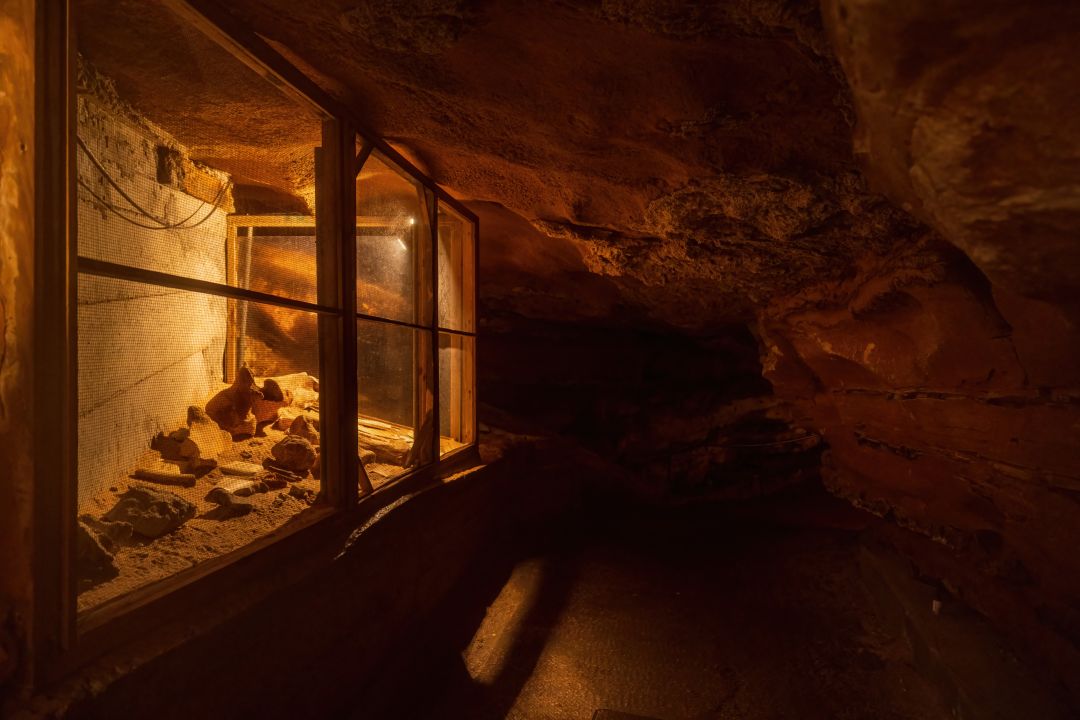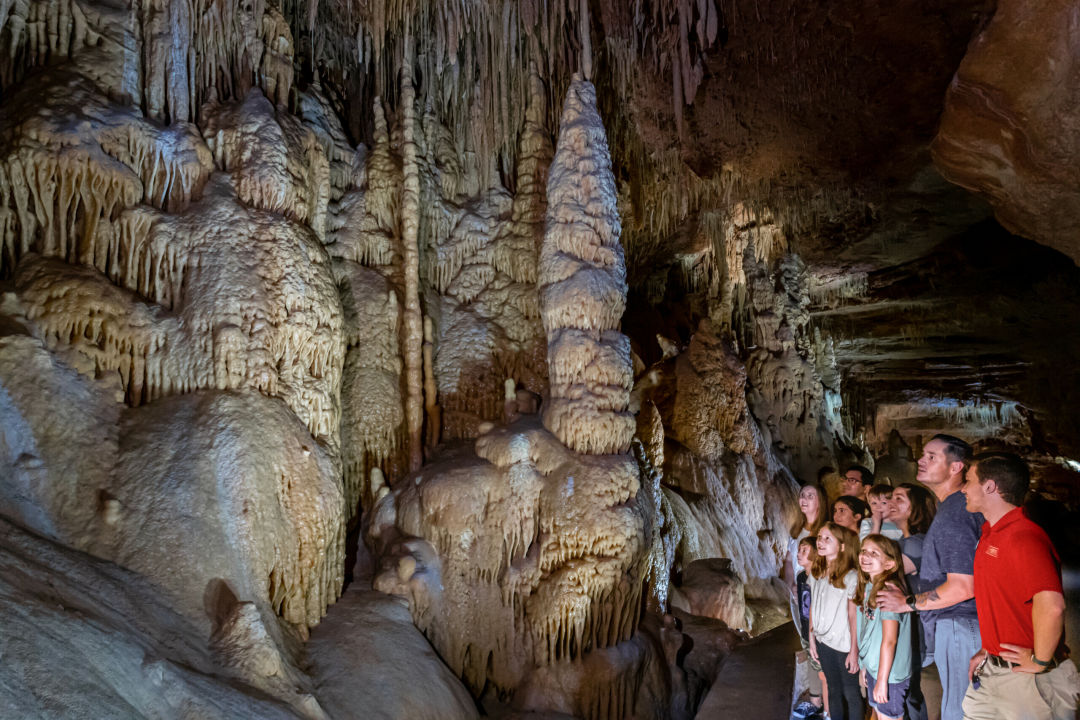Our Favorite Caves in Texas to Go Spelunking (Yes, It’s a Thing)

Getting ready to watch the bats emerge at Devil’s Sinkhole.
One of Texas’s most peculiar natural wonders cannot be seen in most regions of the state—or from above ground, for that matter. Below the bedrock in Central Texas, along the Balcones Fault Zone, you’ll find clusters of caves.
This elaborate underground system formed from limestone and gypsum mixing with water for millions of years, a geological phenomenon that makes for a great cave. There are more than 5,000 documented caves in the state, but only about a dozen of them are open to the public, and most are concentrated in Texas Hill Country. Spelunking, or cave exploring, takes you on a journey through time, and some might even say to another world.
Discover clusters of icicle drip formations known as stalactites and stalagmites or distinctive shapes formed out of calcite and crystals that look like smooth caramel popcorn, mushroom silhouettes, and skull-shaped rocks; and stand in awe at the towering pillars connected from floor to ceiling while listening to the stories of prehistoric animals that got stuck in time.
Here are some of our favorite caves in Texas.
Cascade Caverns
Boerne
With more than 90 years operating cave tours and as one of the oldest discovered caves in the state, Cascade Caverns has stood the test of time. Its cave formations are said to be millions of years old, and the current stream of water in them mean they’re still 95 percent active. Located in Kendall County, 30 miles northwest of San Antonio, the 103-acre park offers camping, hiking trails, cave tours, and plenty of history.
Book the fully guided Downunder Tour, a one-hour adventure of five different “rooms” throughout the cave, including the Lake Room that’s home to salamanders and the 50-foot-high Cathedral Room, a sight that makes you forget you’re on planet Earth. Look out for some unusual formations like the Diamond Ceiling, Soda Straw Rainforest, Twin Sisters, and the Skull. For groups of 10 or more, take the four-hour Aquifer Tour where you’ll get a flashlight, cave helmet, and gloves to trek through depths off the beaten path.
Pro tip: The cave has a temperature of roughly 60 degrees, regardless of the weather outside, so bring a jacket.
Devil’s Sinkhole State Natural Area
Rocksprings
The Devil’s Sinkhole, also northwest of San Antonio, is a nationally recognized natural landmark that holds one of the state’s largest bat colonies. On warm evenings, from late spring to early fall, over three million Mexican free-tailed bats make an appearance at dusk (timing may vary) and spiral out in search of food from the 140-foot-deep, 50-foot-wide vertical tunnel that connects to the cavern.
While the cavern itself is a protected area that cannot be explored by visitors, you can catch the performance of bats with a guided tour at an aboveground viewing area. With 1,860 acres of nature to explore, book a birding tour or a guided nature walk, then head to the sinkhole at sundown to watch the bats emerge.
Pro tip: For a full weekend adventure, drive down to Kickapoo Cavern State Park, which offers camping, hiking, biking, bird-watching, and you guessed it, more caves.

At Inner Space Caverns, expect to see prehistoric fossils from a woolly mammoth and saber-toothed tiger.
Image: Kit Leong/Shutterstock.com
Inner Space Cavern
Georgetown
Before 1963, Inner Space Cavern, located 30 minutes north of Austin, had no human contact until it was discovered by the Texas Highway Department when crews were drilling for Interstate 35. Three years later, the cavern opened for business, with over one mile and a maximum depth of 69 feet to spelunk, according to the Texas Speleological Survey. Aside from viewing the cave’s unique limestone formations, expect to see prehistoric Ice Age fossils from a woolly mammoth, saber-toothed tiger, and giant sloth that were discovered by archaeologists.
There are three different tours you can choose from. The standard Adventure Tour will guide you along a well-lit path for one hour, and the 90-minute Hidden Passages Tour gives you a chance to explore a new and slightly underdeveloped trail using a provided flashlight. For those who want to spend three to four hours exploring parts of the cave that require a bit of crawling, squeezing, and getting dirty, the Wild Cave Tour is the best expedition. The most challenging tour, it happens only on weekends, a reservation is required, and you must be 13 or older. No reservation is required for the two other tours.
Pro tip: Try the new tandem zip ride above ground, called the Saber Tooth, which lifts you 130 feet into the air and rides down at 33 mph.

New parts of the Natural Bridge Caverns were discovered in 2019.
Natural Bridge Caverns
San Antonio
Natural Bridge Caverns, halfway between San Antonio and New Braunfels, is a popular family-owned and operated cave that was discovered by college students in 1960. Its name comes from the natural 60-foot limestone bridge that’s the same length as the cave’s entrance. In 2019, the owners went on a 19-plus-hour expedition to uncharted areas of the cave and discovered more than 1,600 feet of new passages, including chambers and lakes.
Explore the cavern with plenty of guided tours to choose from, including the newest one, Hidden Wonders, which opened this year. The tour features new areas of the cave like the amphitheater (available for events), a light show that tells the story of the cavern, and a Belt Assisted Transport known as the BAT. At 160 feet below ground, you’ll see everything from stalagmites and stalactites to flowstones and soda straws. Other options include the Discovery tour and the Adventure tour, which feature a few opportunities to go spelunking around special sections of the cave.
Pro tip: Up above ground, visitors can enjoy family-friendly activities including zip-lining, a 5,000-square-foot maze, fossil and gem mining, shopping, and dining at the restaurant, as well as a high ropes course.
Wonder World Cave and Adventure Park
San Marcos
Unlike other caves in Texas that were made by water, the World Cave and Adventure Park in San Marcos was created by ancient earthquakes. Established 120 years ago as one of the first cave tours in the state, the attraction is home to fossilized prehistoric life, boulders strangely suspended in midair, walls with sharp and dry edges (due to it being a dry-formed cave), and a slightly warmer temperature of 72 degrees.
At the lowest part of the cave, you can see a wishing well made from the clear waters of Edwards Aquifer, and another viewing area has a ceiling created from an old seabed filled with fossilized insects. The tour takes you underground for 45 minutes with a guide who shares all the geological history and stories about the cave. Take the elevator, or “Stratavator,” back to the surface and toward the 190-foot-high Tejas Observatory Tower to snap a photo of the view. Then take a spin in the Anti-Gravity House, where water flows uphill. Finally, take a quick train ride through a waterfall to an animal park where you can feed deer and turkeys.
Pro tip: Bring a picnic-style lunch to spend a full day exploring the park.




